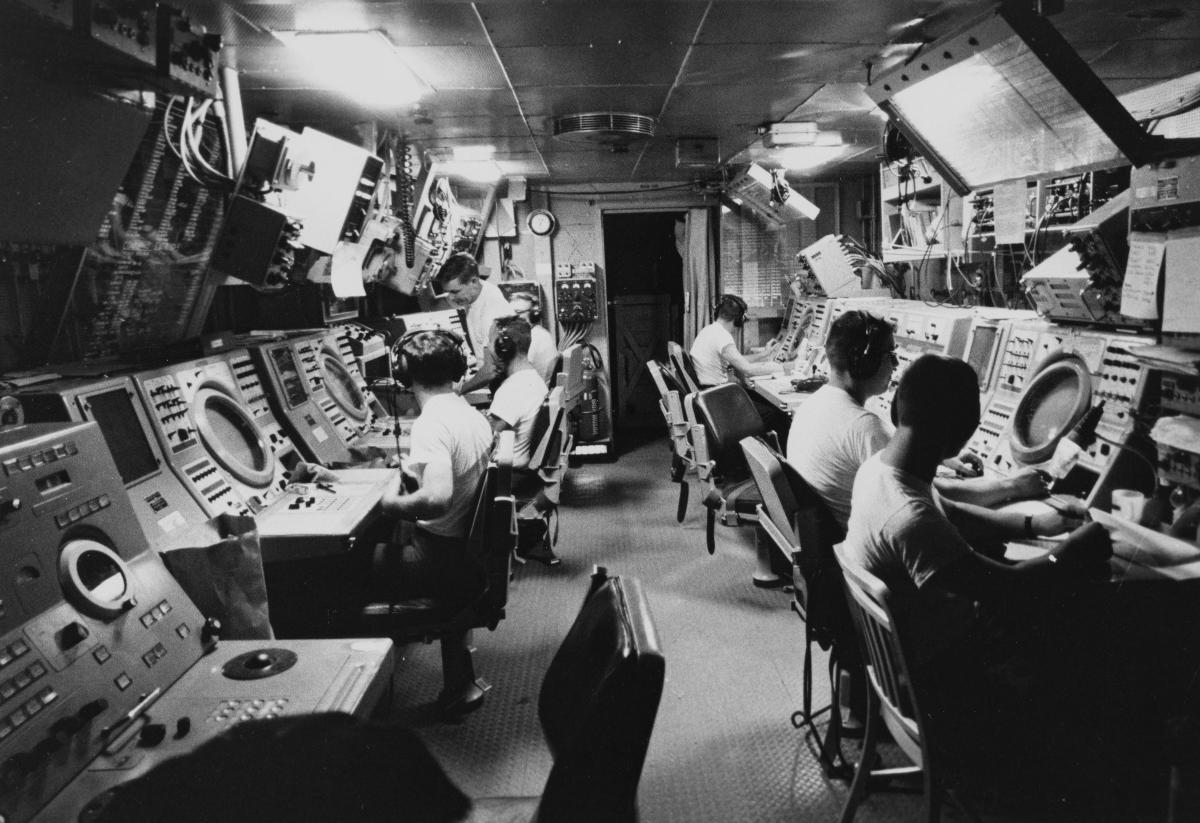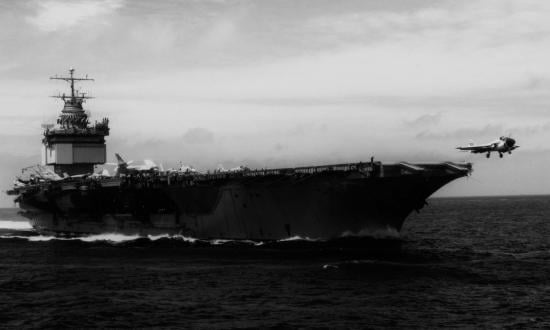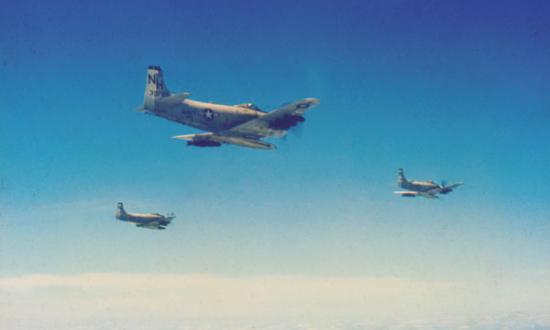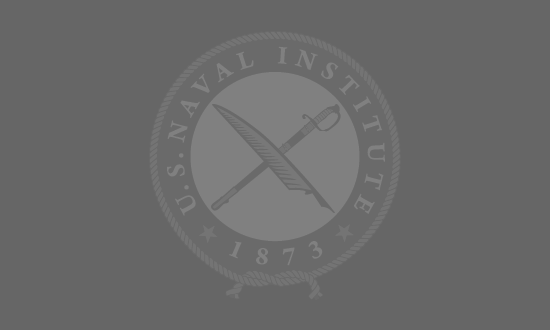Second of Three Parts
Without any delay, Captain “Boot” Hill and Commander Hoskins got very busy. Rear Admiral Ramage—who became just the sixth man in Pacific Command to be informed about the POW rescue and was given the task to conduct the diversion—needed a lot of help. He had less than nine hours left before launching the first aircraft. Because electronic transmissions of the OPORD were not permitted, they had to fly by helicopter from one carrier to another to brief hurriedly assembled skippers and deliver them paper copies of the OPORD they were to conduct that night. Someone had to deliver the OPORD to the land-based carrier tankers at Da Nang and then deliver a copy of it to Brigadier General Manor. As retired Rear Admiral Hill related to me more than 30 years later, they were all surprised by the short notice to respond and had the same unanswerable questions about what was happening. Was this the end of the long-standing bombing pause? Why no ordnance and only flares? He would say the same thing to all. Retired Rear Admiral Bruce Boland, who commanded the VF-24 squadron on board the USS Hancock (CVA-19), remembers: “Hill told us that he could not say why we were doing this operation but when it was over we would all be proud of being involved in it. He was right!”1
(U.S. Naval Institute Photo Archive)
Carrier skippers and flying unit commanders were not the only ones that needed to be notified in person about the mission that would unfold that night. There were several support ships that needed to participate. One of these was the USS Wainwright (DLG-28), which arrived on station that day from her prior mission off the coast of Korea. She was a sophisticated, technologically up-to-date floating air traffic control center of the Vietnam War era with capability to control and direct air combat operations. A cruiser armed with Terrier missiles, she served as a PIRAZ (Positive Identification Radar Advisory Zone) ship. She was linked with other ships through Naval Tactical Data System (NTDS), which provided carrier Combat Information Centers with real time displays of covered airspace.
The PIRAZ ship’s basic function was to provide positive identification and tracking of any aircraft within her radar coverage and from space when tied in by airborne surveillance radars on E-1Bs. More than a dozen radar operators with computer consoles could maintain around-the-clock vigilance to provide advisories to as many as 150 aircraft. These could vary from normal flight following to attack warnings and vectoring of friendly fighters for intercepting and destroying enemy aircraft. They could assist aircraft by steering them to tankers for airborne refueling and provide vital inputs for rescue of downed crewmembers. Any ship equipped with NTDS could selectively monitor any activity in real time with updates from each new sweep of the Wainwright’s radar antenna.
Busy Skies for Diversionary Action
There would be significant congestion during aircraft launches and recoveries. Each carrier needed air traffic control services equal to a relatively busy mainland airport. That night there would be three such airports within a one-degree square box that comprised the Yankee Station. (At the 19th parallel, one degree of longitude measures 60 nautical miles and one degree of latitude is 56.5 nautical miles.) Obviously, the maneuverable air spaces of carriers would overlap and vary with their changing locations relative to each other. They would be moving within Yankee Station, sailing into the wind at about 15 nautical miles per hour during aircraft launches and recoveries. Once all of the aircraft were off their decks, they would have to turn around so that they could sail into the wind again when their aircraft returned to their decks. That would be a lot of carrier and aircraft movement confined to a small geographical space. Furthermore, each carrier had a flotilla of supporting ships that also would be on the move. All would have to participate in a carefully choreographed water ballet taking place inside of a 60-square-mile box.
The newly arrived Wainwright’s radar controllers would earn their pay that night. During a period of more than two hours, they would track unprecedented numbers of blacked-out and radio-silenced Navy and Air Force aircraft that would fly multiple tracks overland north of Haiphong and over the Gulf of Tonkin. Their tracks would have time and altitude separations, but they would cross over each other in various congested locations. They would have to be alert to monitor them across their radar scopes and pay close attention to coded altitude data squawked by each aircraft’s IFF (Identification Friend or Foe) transmitter.
The first Navy aircraft in the air at 0100 on 21 November 1970 was the USS Ranger’s (CVA-61) KA-3B tanker land-based at Da Nang Air Base in South Vietnam. Following it there were three pairs of EKA-3B ECM (electromagnetic countermeasures) tankers which belonged to each one of the carriers. They were too heavy for normal operations from the carrier decks. Besides being fully loaded with fuel, they performed a dual mission. Their primary one was to engage the enemy in electronic warfare with sophisticated electronic countermeasures equipment. They flew on a 42-mile-long track spread out at altitudes of 21,000, 23,000, and 24,000 feet just outside of lethal range of surface-to-air missiles (SAMs) and jammed all detected radar and radio frequencies of the enemy. Their secondary role as tankers was to provide fuel for any Navy aircraft in need. In addition to these seven tankers there were six more. Four were A-7s launched from the USS Oriskany (CVA-34) and two A-6s from the Ranger.
The first attacking aircraft were six A-7s from the Oriskany. They departed on track Bravo from NSAR (North Search and Rescue) station which was a ship with a tactical air navigation transmitter (TACAN) that gave distance and bearing for using aircraft. Flying in pairs at two-minute intervals starting at 0130, they flew inland north of Hanoi in the vicinity of Kep Air Base, where they turned around and, heading east, began dropping flares. Each one carried eight two-million-candle power Mk-24 flares that they began launching at 15-second intervals starting at 0152.
The second wave of attack aircraft, eight A-7s from the Ranger, departed NSAR on track Alpha at 0132 with the same two-minute time separation. This track took them flying a triangular pattern over the islands east of Haiphong. They started dropping 64 more flares at 0156. These illuminated an area east of the land being lit up by the 48 flares from the A-7s on track Bravo.
The third attack wave consisted of eight A-6s, also from the Ranger, on track Charlie. They simulated mining of Haiphong Harbor by dispensing clouds of chaff on their lower-level track that saturated the enemy’s radar scopes while the 112 flares dropped by 14 A-7s illuminated air space to the north.
There were 24 more naval aircraft in this diversionary attack. All had specific defensive assignments and all but three were armed for defense against the enemy. Two were airborne radar platform E-1B “Willy Fudds” for monitoring air traffic and for assisting in MiG detection and vectoring. One belonged to the Oriskany and the other to the Ranger. The third one was a P-3 Orion with Big Look long-range surveillance radar. The Orion’s home base was Guam, but this one was launched from its forward staging base at Da Nang.
CT-77 OPORD required four F-4s from the Ranger to conduct MiGCAP (MIG combat air patrol) to protect the 22 unarmed attack aircraft. Next came five A-7 “Iron Hand” anti-SAM site suppressing fighters, along with four A-7s for RESCAP (Rescue combat air patrol). Finally, from the Ranger came two more F-4s to provide TARCAP (target). The Oriskany was tasked to launch two F-8 fighters for BARCAP (barrier) to protect the Air Force’s two RC-135 Combat Apples, one RC-135 radio monitor and relay aircraft, and two KC-135 tankers. The Oriskany also launched four more F-8 FORCECAPs to protect the entire force.
Not counted among the 59 specified aircraft in the OPORD were rescue helicopters that normally watch over the carriers during aircraft launches and recoveries. The OPORD listed 22 various standby alert aircraft that had to be ready to replace anyone who dropped out of their assigned routes and orbits for any reason. Eight were ready on the deck of the Ranger and seven each on the Oriskany and Hancock.
‘Precise Execution . . . Commendable’
None of the pilots and air crew members who flew in the Navy’s aircraft in those early hours of 21 November 1970 knew that their mission was designed to support a POW rescue. Neither did Commander Lawrence C. Chambers, air boss of the Oriskany, who launched and recovered 24 of her aircraft. Fifty years later, as a retired rear admiral, he recalled: “We knew it was big when we launched every flyable F-8, the A-6’s and the A-7’s plus the Willy Fudd for a night hop in the middle of the night with marginal weather in the Gulf of Tonkin. But we didn’t know the mission until after the recovery, when Captain Frank S. Haak, skipper of the Oriskany, informed us.”2
(U.S. Naval Institute Photo Archive)
Brigadier General Manor’s mission planners (I was privileged to be one of them) were not aware of the enormity of this naval operation. We did not learn about its size and success until we reassembled at Eglin Air Force Base for a detailed post-raid debriefing. Not knowing much about carrier operations, we just anticipated a few aircraft dropping flares somewhere in the vicinity of Haiphong. Vice Admiral Bardshar’s CT-77 did not have a representative at the debriefing and did not provide a written after’action report. We heard only praises from those members of Manor’s staff who were with him at the Monkey Mountain command post.
They had a very good view of naval activity on big display screens, which showed aircraft movements in real time by Naval Tactical Data System (NTDS) from the PIRAZ ship Wainwright. None of us had seen the CTF-77 OPORD, because after the decision to execute the mission 24 hours early, there was no time for it to reach us prior to the Air Force’s aircraft launches from Thailand. We did not know that Bardshar had gone to the Subic Bay to prepare the OPORD in the departing USS America (CVA-66) and that he tasked his subordinate, Rear Admiral Ramage, to execute the diversion.
Manor violated Bardshar’s instructions to destroy his copy of the FT-77 OPORD he had received just before assuming command of the entire operation at Monkey Mountain. He brought it with him to Florida, where we could see it for the first time. It became an attachment to his “Commander, JCS Joint Contingency Task Group Report on the Son Tay Prisoner of War Rescue Operation.” His comments summarized naval participation on a single double-spaced typewriter page. It was based on what he and his staff learned at the command post while they monitored activities over the Gulf of Tonkin and on a brief summary of the OPORD.
In his commander’s comments at the beginning of the report he devoted the following paragraph to praise the Commander of TF-77 for the diversionary operation:
The diversionary actions performed by Carrier Task Force 77 were vital to the overall success of the mission. The results of this effort were exactly as foreseen during the planning phase. It caused the enemy defense authorities to split their attention and concern thereby contributing greatly to the confusion and chaos which resulted. In short, it served to deny the option of concentrating his attention to our true and primary mission. The timing of the Navy diversion was precisely according to plan. The U. S. Navy planning and mission execution was superb in every respect. I am deeply grateful for the wholehearted and enthusiastic support received from the Commander of Carrier Task Force 77.3
Based on observations from the Monkey Mountain command post, he documented the following:
NVN reaction was initially slow, reaching a peak of intensity as the second wave was over the Haiphong Harbor. To the degree observable, the principal objective of the Navy diversionary effort was achieved. The density of Navy operations in the Gulf of Tonkin was the most extensive Navy night operation of the SEA [Southeast Asia] conflict. Considering that two of the carriers arrived in theater just prior to this operation, the precise execution of this mission without incident is commendable.4
A Fuller Story Begins to Emerge
Benjamin F. Schemmer wrote the first comprehensive book on the Son Tay raid in 1976, more than five years after the event. At that time he was the editor and publisher of the Armed Forces Journal and had many contacts in Washington with officials from the Pentagon, as well as with some key individuals from intelligence agencies. They provided him with some fill-in details about what went on in our nation’s capital. Then he had the two-volume text of the three-volume report by Brigadier General Manor, which provided him with declassified information about the raid.
However, he had difficult time getting personal inputs from the raid’s dispersed planners and participants. They were scattered throughout the world on other military assignments and were still reluctant to provide operational information, which they believed was still classified. Naval participants were even more reticent. The few key individuals, who learned about the diversion’s purpose before its execution heeded Bardshar’s orders that only he could approve news releases about the operation and destroyed the OPORD. It was only one Top Secret event for the flying participants, in which they got involved on one night in the Gulf of Tonkin without being informed about its purpose. Some learned about it after their return to the carriers, and the rest from the military radio or from the Stars and Stripes news reports.
The few key officers from the Joint Contingency Task Group (JCTG) who began lecturing about the Son Tay raid did not have sufficient information about the Navy’s diversionary role. Consequently, appropriate credit for the naval contribution was not properly expressed. In 1977–78 I had several opportunities to hear presentations about the Son Tay raid to students of the Air Force Special Operations School based at Hurlburt Field, Florida. It was presented regularly by retired Colonel “Bull” Simons and one raid helicopter pilot from the Aerospace Rescue and Recovery Service at Eglin. Whenever a helicopter pilot was not available, the school’s commander, Colonel Richard Dutton, former inmate of Son Tay, invited me to provide the Air Force’s input. On those occasions both of us complimented the Navy for outstanding support. However, I don’t recall any questions about naval operational details. Audiences were satisfied with hearing about the Navy having flown 59 aircraft compared with the Air Force’s 57, and that 20 SAMs were fired east of Hanoi and 16 over Son Tay. It was the same after I began my solo lecturing about the raid.
The American public did not learn much about the Navy’s involvement in the raid from the media. News stories about the raid focused on the Army and the Air Force, the two services that were in Brigadier General Manor’s JCTG. Initially, much of that publicity was critical and political. Some depicted it as a failure and a military adventure of unpopular President Richard Nixon. There was no criticism of the Navy. The Navy was not a part of the JCTG’s elaborate preparation for the raid, and its support for it was viewed only as a part of its normal wartime duty.
A very good account and analysis of the special operations aspects of the raid came from Admiral William H. McRaven, who later organized and oversaw Operation Neptune Spear that killed Osama bin Laden. As a student at the Naval Postgraduate School in Monterey, California, in 1993, he wrote a Master of Arts degree thesis on “The Theory of Special Operations.” It was later published as a book, Spec Ops: Case Studies in Special Operations Warfare: Theory and Practice. In it he gave an excellent evaluation of Operation Kingpin; however, he mentioned the naval diversion only three times.
First, he quoted an observation by one helicopter pilot when his aircraft formation crested the last mountain ridge line and descended from 5,900 ft. in to the Black and Red River Basin: “At the same moment, approaching the coast from the east, the Navy diversionary raid was in progress, which utterly confused the enemy defenses, focusing their attention away from Son Tay.”5
Then he commented: “The Navy diversionary raid proceeded as planned. It is estimated that 20 SAMs were fired at the force, but no casualties were sustained. It was later reported that the ‘density of the Navy operations in the Gulf of Tonkin during the Son Tay raid’ was the most extensive Navy night operation of the SEA conflict.”6
Finally, he quoted Brigadier General Manor’s report thanking Vice Admiral Bardshar “for the wholehearted and enthusiastic support received from the Commander of Carrier Task Force 77.”7
This is not at all surprising. There wasn’t much more information about the diversion at the time he wrote his thesis. Bardshar did not allow press releases, and his personnel did not advertise their participation in that one night’s event. Also, as a student, McRaven did not have time to make contacts with still-living TF-77 participants. It took me more than three years of phone calls and emails to accumulate sufficient information to present the Navy’s story in my book.
This lack of historical documentation for the Navy’s role in the Son Tay raid troubled me a lot. So, some 30 years later, I began to look for still-available personnel from TF-77 to gather details about their participation.
Continued next week
1. RADM Bruce Boland, USN (Ret.), email to author, 2 April 2001.
2. RADM Lawrence C. Chambers, USN (Ret.), email message to author, 15 December 2020.
3. BGEN LeRoy J. Manor, USAF, “Commander, JCS Joint Contingency Task Group Report on the Son Tay Prisoner of War Rescue Operation, Part I,” 70.
4. Manor, “Report,” iv.
5. VADM William H. McRaven, USN (Ret.), Spec Ops: Case Studies in Special Operations Warfare: Theory and Practice (New York: Random House, 2009), 311.
6. McRaven, Spec Ops, 317.
7. McRaven, 327.










